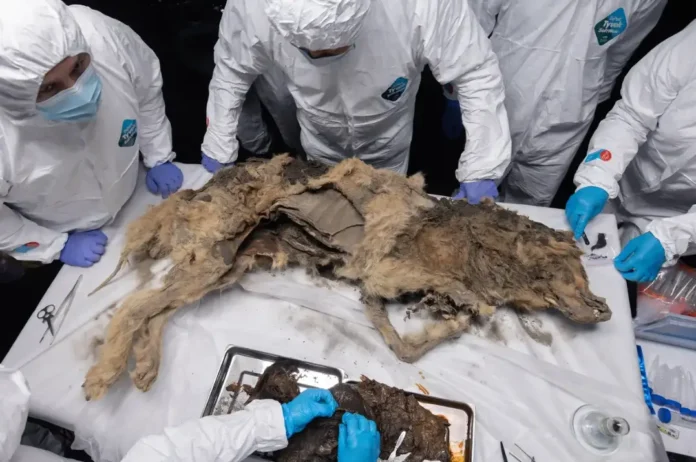In the vast, frozen expanse of Siberia, a remarkable discovery has captivated the scientific community and the public alike. Buried deep within the permafrost, a remarkably well-preserved mummified wolf, dating back an astounding 44,000 years, has emerged, offering a tantalizing glimpse into the distant past. This ancient predator, frozen in time, has become a treasure trove of information, shedding light on the incredible resilience of life and the secrets hidden within the icy tundra.

The Remarkable Discovery
The discovery of this ancient wolf was made in 2021 by residents of the Republic of Sakha, also known as Yakutia, in eastern Russia. Embedded in the thick permafrost, the mummified remains were remarkably well-preserved, with the wolf’s teeth, fur, and even some of its internal organs intact. This unprecedented find represents the first complete adult wolf from the late Pleistocene era, a period spanning from 2.6 million to 11,700 years ago, to ever be discovered.
Preserving the Past: The Science of Permafrost Mummification
The remarkable state of preservation of the wolf can be attributed to the unique conditions of the Siberian permafrost. Through a process known as “mummification by freezing,” the cold and dry environment of the permafrost dehydrated the wolf’s soft tissues, allowing its body to be preserved in a frozen time capsule. This extraordinary process has not only kept the wolf’s physical form intact but has also protected the potential treasure trove of information hidden within its remains.
Unlocking the Secrets: The Necropsy Reveals
With great anticipation, researchers at the North-Eastern Federal University in Yakutsk, Russia, have undertaken a comprehensive necropsy, or animal autopsy, on the ancient wolf. By examining the wolf’s internal organs and gastrointestinal tract, they hope to uncover a wealth of information about its lifestyle, diet, and even the ancient microbiota and viruses it may have harbored.
Insights into the Pleistocene Predator
The researchers believe that this wolf was an “active and large predator” during the Pleistocene era, likely hunting in the flat, cold environments that were home to mammoths, woolly rhinoceroses, extinct horses, bison, and reindeer. By studying the contents of the wolf’s stomach and digestive tract, the scientists aim to gain a deeper understanding of the wolf’s prey and the broader ecosystem of the time.
Revealing the Wolf’s Genome
In addition to the physical examination, the research team plans to study the wolf’s genome, which will provide valuable insights into its genetic lineage and how it relates to other ancient wolves from the region. This information could shed light on the evolutionary history of the species and how it compares to its modern-day counterparts.
Unlocking the Mysteries of Ancient Microbes
One of the most intriguing aspects of the wolf’s discovery is the potential for insights into ancient microbial communities. Researchers have found that living bacteria can survive for thousands of years, preserved within the permafrost. By analyzing the wolf’s internal organs and gastrointestinal tract, the team hopes to uncover a “snapshot of the biota of the ancient Pleistocene,” potentially revealing unknown microorganisms that could hold promise for medical and biotechnological applications.
Implications for Understanding the Past
The discovery of this 44,000-year-old wolf is not just a remarkable find, but also a crucial piece in the puzzle of understanding the Pleistocene era. By studying the wolf’s remains, researchers can gain invaluable insights into the climate, ecology, and even the potential threats that existed during this pivotal period in Earth’s history.
Collaboration and Ongoing Investigations
The wolf necropsy is part of a broader collaborative effort to study the ancient wildlife that inhabited the region during the Pleistocene. Other species, such as fossil hares, horses, and a bear from the Holocene era, have also been examined by the research team. This comprehensive approach ensures that the insights gleaned from the wolf’s discovery can be placed within a larger context, providing a more holistic understanding of the past.
Expanding the Frontiers of Knowledge
As the team continues to investigate the wolf and other ancient specimens, they are poised to make groundbreaking discoveries that could revolutionize our understanding of the Pleistocene era. The potential to uncover unknown microorganisms, trace the evolutionary lineages of extinct species, and shed light on the environmental conditions of the past holds immense promise for advancing scientific knowledge.
Confronting the Challenges of a Changing Climate
The thawing of the Siberian permafrost, driven by rising global temperatures, has not only revealed this remarkable wolf but also raised concerns about the potential release of ancient pathogens. The 2016 outbreak of anthrax in the Yamal Peninsula, caused by the thawing of a reindeer carcass, serves as a sobering reminder of the risks associated with the melting of these frozen time capsules.
The Importance of Preserving the Past
As the world grapples with the consequences of climate change, the discovery of the 44,000-year-old wolf underscores the vital importance of preserving and studying the remnants of the past. These ancient specimens hold the key to unlocking the secrets of our planet’s history, and their protection is crucial for the advancement of scientific understanding and the development of innovative solutions to present-day challenges.

Conclusion: A Frozen Treasure Trove Unveiled
The unearthing of the 44,000-year-old Siberian wolf is a testament to the resilience of life and the power of scientific inquiry. This remarkable discovery has captivated the imagination of researchers and the public alike, promising to unveil the mysteries of the distant past and shed light on the complex interplay between the environment, evolution, and the enduring spirit of exploration. As the scientific community delves deeper into the wolf’s secrets, the world eagerly awaits the insights that will emerge from this frozen treasure trove.




